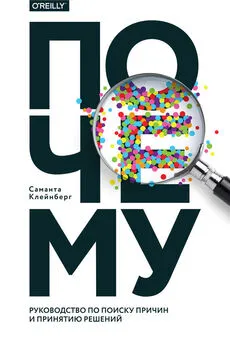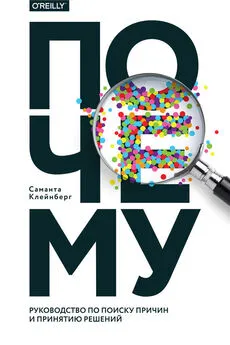Саманта Клейнберг - Почему
- Название:Почему
- Автор:
- Жанр:
- Издательство:Литагент МИФ без БК
- Год:2017
- Город:Москва
- ISBN:978-5-00100-593-3
- Рейтинг:
- Избранное:Добавить в избранное
-
Отзывы:
-
Ваша оценка:
Саманта Клейнберг - Почему краткое содержание
Книга будет интересна аналитикам, философам, исследователям, медикам, экономистам, юристам, начинающим ученым, всем, кто имеет дело с массивами данных и хочет научиться критическому мышлению.
На русском языке публикуется впервые.
Почему - читать онлайн бесплатно полную версию (весь текст целиком)
Интервал:
Закладка:
Moher, D., Schulz, K. F., and Altman, D. G. (2001). The CONSORT statement: Revised recommendations for improving the quality of reports of parallel-group randomised trials. The Lancet , 357(9263): 1191–1194.
Morris, M. W. and Peng, K. (1994). Culture and Cause: American and Chinese Attributions for Social and Physical Events. Journal of Personality and Social Psychology , 67(6): 949–971.
Mosca, L., Manson, J. E., Sutherland, S. E., Langer, R. D., Manolio, T., and Barrett-Connor, E. (1997). Cardiovascular disease in women: A statement for healthcare professionals from the American Heart Association. Writing Group. Circulation , 96(7): 2468–2482.
Mostofsky, E., Rice, M. S., Levitan, E. B., and Mittleman, M. A. (2012). Habitual Coffee Consumption and Risk of Heart Failure: A Dose-Response Meta-Analysis. Circulation: Heart Failure , 5(4): 401–405.
Mott, N. L. (2003). The Current Debate on Juror Questions: To Ask or Not to Ask, That Is the Question. Chicago-Kent Law Review , 78: 1099.
Muntner, P., Safford, M. M., Cushman, M., and Howard, G. (2014). Comment on the Reports of Over-estimation of ASCVD Risk Using the 2013 AHA/ACC Risk Equation. Circulation , 129(2): 266–267.
Murphy, K. (2002). Dynamic Bayesian Networks: Representation, Inference and Learning . PhD thesis, University of California, Berkley.
Nadelhoffer, T. (2004). On Praise, Side Effects, and Folk Ascriptions of Intentionality. Journal of Theoretical and Philosophical Psychology , 24(2): 196–213.
Narayanan, A. and Shmatikov, V. (2008). Robust Deanonymization of Large Sparse Datasets. In Proceedings of the IEEE Symposium on Security and Privacy .
Newburger, J. W., Takahashi, M., Gerber, M. A., Gewitz, M. H., Tani, L. Y., Burns, J. C., Shulman, S. T., Bolger, A. F., Ferrieri, P., Baltimore, R. S., Wilson, W. R., Baddour, L. M., Levison, M. E., Pallasch, T. J., Falace, D. A., and Taubert, K. A. (2004). Diagnosis, Treatment, and Long-Term Management of Kawasaki Disease. Circulation , 110(17): 2747–2771.
Nieman, D. C. (1994). Exercise, Infection, and Immunity. International Journal of Sports Medicine , 15(S 3):S131–S141.
Norenzayan, A. and Schwarz, N. (1999). Telling what they want to know: Participants tailor causal attributions to researchers’ interests. European Journal of Social Psychology , 29(8): 1011–1020.
Normore, A. H. and Ilon, L. (2006). Cost-Effective School Inputs: Is Class Size Reduction the Best Educational Expenditure for Florida? Educational Policy , 20(2): 429–454.
Noseworthy, J. H., Ebers, G. C., Vandervoort, M. K., Farquhar, R. E., Yetisir, E., and Roberts, R. (1994). The impact of blinding on the results of a randomized, placebo-controlled multiple sclerosis clinical trial. Neurology , 44(1): 16–20.
Novick, L. R. and Cheng, P. W. (2004). Assessing Interactive Causal Influence. Psychological Review , 111(2): 455–485.
Oakes, B., Tai, A. K., Cingцz, O., Henefield, M. H., Levine, S., Coffin, J. M., and Huber, B. T. (2010). Contamination of human DNA samples with mouse DNA can lead to false detection of XMRV-like sequences. Retrovirology , 7: 109.
Oakes, L. M. (1994). Development of Infants’ Use of Continuity Cues in Their Perception of Causality. Developmental Psychology , 30(6): 869–879.
O’Malley, K. J., Cook, K. F., Price, M. D., Wildes, K. R., Hurdle, J. F., and Ashton, C. M. (2005). Measuring Diagnoses: ICD Code Accuracy. Health Services Research , 40(5p2): 1620–1639.
Ou, Z. Y., Pereira, S. F., Kimble, H. J., and Peng, K. C. (1992). Realization of the Einstein-Podolsky-Rosen paradox for continuous variables. Physics Review Letters , 68(25): 3663–3666.
Paprotka, T., Delviks-Frankenberry, K. A., Cingöz, O., Martinez, A., Kung, H.-J., Tepper, C. G., Hu, W.-S., Fivash, M. J., Coffin, J. M., and Pathak, V. K. (2011). Recombinant origin of the retrovirus XMRV. Science , 333(6038): 97–101.
Patberg, W. R. and Rasker, J. J. (2004). Weather effects in rheumatoid arthritis: From controversy to consensus. A review. The Journal of Rheumatology , 31(7): 1327–1334.
Pearl, J. (2000). Causality: Models, Reasoning, and Inference . Cambridge University Press, Cambridge.
Pearl, J. (2014). Understanding Simpson’s Paradox. The American Statistician , 68(1): 8–13.
Pearson, K., Lee, A., and Bramley-Moore, L. (1899). Mathematical Contributions to the Theory of Evolution. VI. Genetic (Reproductive) Selection: Inheritance of Fertility in Man, and of Fecundity in Thoroughbred Racehorses. Philosophical Transactions of the Royal Society of London. Series A, Containing Papers of a Mathe-matical or Physical Character , 192: 257–330.
Peng, K. and Knowles, E. D. (2003). Culture, Education, and the Attribution of Physical Causality. Personality and Social Psychology Bulletin , 29(10): 1272–1284.
Pennington, N. and Hastie, R. (1986). Evidence Evaluation in Complex Decision Making. Journal of Personality and Social Psychology , 51(2): 242–258.
Pennington, N. and Hastie, R. (1988). Explanation-based decision making: Effects of memory structure on judgment. Journal of Experimental Psychology: Learning, Memory, and Cognition , 14(3): 521–533.
Pennington, N. and Hastie, R. (1992). Explaining the Evidence: Tests of the Story Model for Juror Decision Making. Journal of Personality and Social Psychology , 62(2): 189–206.
Perales, J. C., Shanks, D. R., and Lagnado, D. (2010). Causal Representation and Behavior: The Integration of Mechanism and Covariation. Open Psychology Journal , 3(1): 174–183.
Perotte, A. and Hripcsak, G. (2013). Temporal Properties of Diagnosis Code Time Series in Aggregate. IEEE Journal of Biomedical and Health Informatics , 17(2): 477–483.
Perwien, A. R., Johnson, S. B., Dymtrow, D., and Silverstein, J. (2000). Blood Glucose Monitoring Skills in Children with Type I Diabetes. Clinical Pediatrics , 39(6): 351–357.
Phillips, C. V. and Goodman, K. J. (2004). The missed lessons of Sir Austin Bradford Hill. Epidemiologic Perspectives & Innovations , 1(1): 3.
Pivovarov, R. and Elhadad, N. (2012). A hybrid knowledge-based and data-driven approach to identifying semantically similar concepts. Journal of Biomedical Informatics , 45(3): 471–481.
Power, D. J. (2002). Ask Dan! What is the “true story” about data mining, beer and diapers? DSS News , 3(23).
Price, D. D., Finniss, D. G., and Benedetti, F. (2008). A Comprehensive Review of the Placebo Effect: Recent Advances and Current Thought. Annual Review of Psychology , 59: 565–590.
Price, H. (1997). Time’s Arrow and Archimedes’ Point: New Directions for the Physics of Time . Oxford University Press, Oxford.
Prinz, F., Schlange, T., and Asadullah, K. (2011). Believe it or not: How much can we rely on published data on potential drug targets? Nature Reviews Drug Discovery , 10(9): 712–713.
Pritchard, C. (2012). Does chocolate make you clever? BBC News. Retrieved from http://www.bbc.com/news/magazine-20356613 .
Pronin, E., Wegner, D. M., McCarthy, K., and Rodriguez, S. (2006). Everyday Magical Powers: The Role of Apparent Mental Causation in the Overestimation of Personal Influence. Journal of Personality and Social Psychology , 91(2): 218–231.
Psillos, S. (2010). Causal Pluralism. In R. Vanderbeeken and B. D’Hooghe (eds.), World-views, Science and Us: Studies of Analytical Metaphysics , pp. 131–151. World Scientific Publishers, Singapore.
R v. Jordan (1956). 4 °Cr App R. 152.
Radelet, M. L. and Pierce, G. L. (1991). Choosing Those Who Will Die: Race and the Death Penalty in Florida. Florida Law Review , 43(1): 1–34.
Redelmeier, D. A. and Tversky, A. (1996). On the belief that arthritis pain is related to the weather. Proceedings of the National Academy of Sciences , 93(7): 2895–2896.
Reichenbach, H. (1956). The Direction of Time . University of California Press, Berkeley. Reprint, Dover Publications, 2000.
Reiss, J. (2007). Time Series, Nonsense Correlations and the Principle of the Common Cause. In F. Russo and J. Williamson (eds.), Causality and Probability in the Sciences , pp. 179–196. College Publications, London.
Reiss, J. (2014). What’s Wrong With Our Theories of Evidence? Theoria , 29(2): 283–306.
Rescorla, R. A. and Wagner, A. R. (1972). A theory of Pavlovian conditioning: Variations in the effectiveness of reinforcement and nonreinforcement. In A. H. Black and W. F. Prokasy (eds.), Classical Conditioning II: Current Theory and Research , pp. 64–99. Appleton-Century-Crofts, New York.
Rhonheimer, J. (writer) and Fryman, P. (director). (2007). Lucky penny [Television series episode]. In Bays, C. and Thomas, C. (producers), How I met your mother . CBS, Los Angeles.
Ridker, P. M. and Cook, N. R. (2013). Statins: New American guidelines for prevention of cardiovascular disease. The Lancet , 382(9907): 1762–1765.
Robins, J. M., Rotnitzky, A., and Scharfstein, D. O. (2000). Sensitivity Analysis for Selection bias and unmeasured Confounding in missing Data and Causal inference models. In M. E. Halloran and D. Berry (eds.), Statistical Models in Epidemiology: The Environment and Clinical Trials , pp. 1–94. Springer-Verlag, New York.
Robinson, J. W. and Hartemink, A. J. (2010). Learning Non-Stationary Dynamic Bayesian Networks. Journal of Machine Learning Research , 11(Dec): 3647–3680.
Robinson, M. J., Erlwein, O. W., Kaye, S., Weber, J., Cingoz, O., Patel, A., Walker, M. M., Kim, W.-J. J., Uiprasertkul, M., Coffin, J. M., and McClure, M. O. (2010). Mouse DNA contamination in human tissue tested for XMRV. Retrovirology , 7: 108.
de Rooij, N. K., Linn, F. H. H., van der Plas, J. A., Algra, A., and Rinkel, G. J. E. (2007). Incidence of subarachnoid haemorrhage: A systematic review with emphasis on region, age, gender and time trends. Journal of Neurology, Neurosurgery & Psychiatry , 78(12): 1365–1372.
Roser, M. E., Fugelsang, J. A., Dunbar, K. N., Corballis, P. M., and Gazzaniga, M. S. (2005). Dissociating Processes Supporting Causal Perception and Causal Inference in the Brain. Neuropsychology , 19(5): 591–602.
Rothman, K. J. (1976). Causes. American Journal of Epidemiology , 104(6):587–592. Reprinted in 141(2), 1995.
Rothman, K. J. (1990). No Adjustments Are Needed for Multiple Comparisons. Epidemiology , 1(1): 43–46.
Rothman, K. J. and Greenland, S. (2005). Causation and Causal Inference in Epidemiology. American Journal of Public Health , 95(S1): S144–S150.
Rothwell, P. M. (2005). External validity of randomised controlled trials: “To whom do the results of this trial apply?” The Lancet , 365(9453): 82–93.
Russell, B. (1912). On the Notion of Cause. Proceedings of the Aristotelian Society , 13(1912–1913): 1–26.
Russo, F. (2006). The Rationale of Variation in Methodological and Evidential Pluralism. Philosophica , 77(1): 97–124.
Russo, F. and Williamson, J. (2007). Interpreting Causality in the Health Sciences. International Studies in the Philosophy of Science , 21(2): 157–170.
Salganik, M. J., Dodds, P. S., and Watts, D. J. (2006). Experimental Study of Inequality and Unpredictability in an Artificial Cultural Market. Science , 311(5762): 854–856.
Sandvei, M., Mathiesen, E., Vatten, L., Müller, T., Lindekleiv, H., Ingebrigtsen, T., NjØlstad, I., Wilsgaard, T., LØchen, M.-L., Vik, A., et al. (2011). Incidence and mortality of aneurysmal subarachnoid hemorrhage in two Norwegian cohorts, 1984–2007. Neurology , 77(20): 1833–1839.
Читать дальшеИнтервал:
Закладка:






![Саманта Даунинг - Моя дорогая жена [litres]](/books/1070823/samanta-dauning-moya-dorogaya-zhena-litres.webp)



